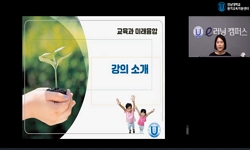Purpose: This study was done to develop a cell phone addiction scale for Korean adolescents. Methods: The process included construction of a conceptual framework, generation of initial items, verification of content validity, selection of secondary it...
http://chineseinput.net/에서 pinyin(병음)방식으로 중국어를 변환할 수 있습니다.
변환된 중국어를 복사하여 사용하시면 됩니다.
- 中文 을 입력하시려면 zhongwen을 입력하시고 space를누르시면됩니다.
- 北京 을 입력하시려면 beijing을 입력하시고 space를 누르시면 됩니다.
부가정보
다국어 초록 (Multilingual Abstract)
included construction of a conceptual framework, generation of initial items, verification of content validity, selection of secondary
items, preliminary study, and extraction of final items. The participants were 577 adolescents in two middle schools
and three high schools. Item analysis, factor analysis, criterion related validity, and internal consistency were used to analyze
the data. Results: Twenty items were selected for the final scale, and categorized into 3 factors explaining 55.45%
of total variance. The factors were labeled as withdrawal/tolerance (7 items), life dysfunction (6 items), and compulsion/
persistence (7 items). The scores for the scale were significantly correlated with self-control, impulsiveness, and cell phone
use. Cronbach’s alpha coefficient for the 20 items was .92. Scale scores identified students as cell phone addicted, heavy
users, or average users. Conclusion: The above findings indicate that the cell phone addiction scale has good validity and
reliability when used with Korean adolescents.
Purpose: This study was done to develop a cell phone addiction scale for Korean adolescents. Methods: The process
included construction of a conceptual framework, generation of initial items, verification of content validity, selection of secondary
items, preliminary study, and extraction of final items. The participants were 577 adolescents in two middle schools
and three high schools. Item analysis, factor analysis, criterion related validity, and internal consistency were used to analyze
the data. Results: Twenty items were selected for the final scale, and categorized into 3 factors explaining 55.45%
of total variance. The factors were labeled as withdrawal/tolerance (7 items), life dysfunction (6 items), and compulsion/
persistence (7 items). The scores for the scale were significantly correlated with self-control, impulsiveness, and cell phone
use. Cronbach’s alpha coefficient for the 20 items was .92. Scale scores identified students as cell phone addicted, heavy
users, or average users. Conclusion: The above findings indicate that the cell phone addiction scale has good validity and
reliability when used with Korean adolescents.
다국어 초록 (Multilingual Abstract)
included construction of a conceptual framework, generation of initial items, verification of content validity, selection of secondary
items, preliminary study, and extraction of final items. The participants were 577 adolescents in two middle schools
and three high schools. Item analysis, factor analysis, criterion related validity, and internal consistency were used to analyze
the data. Results: Twenty items were selected for the final scale, and categorized into 3 factors explaining 55.45%
of total variance. The factors were labeled as withdrawal/tolerance (7 items), life dysfunction (6 items), and compulsion/
persistence (7 items). The scores for the scale were significantly correlated with self-control, impulsiveness, and cell phone
use. Cronbach’s alpha coefficient for the 20 items was .92. Scale scores identified students as cell phone addicted, heavy
users, or average users. Conclusion: The above findings indicate that the cell phone addiction scale has good validity and
reliability when used with Korean adolescents.
Purpose: This study was done to develop a cell phone addiction scale for Korean adolescents. Methods: The process included construction of a conceptual framework, generation of initial items, verification of content validity, selection of secondary ...
Purpose: This study was done to develop a cell phone addiction scale for Korean adolescents. Methods: The process
included construction of a conceptual framework, generation of initial items, verification of content validity, selection of secondary
items, preliminary study, and extraction of final items. The participants were 577 adolescents in two middle schools
and three high schools. Item analysis, factor analysis, criterion related validity, and internal consistency were used to analyze
the data. Results: Twenty items were selected for the final scale, and categorized into 3 factors explaining 55.45%
of total variance. The factors were labeled as withdrawal/tolerance (7 items), life dysfunction (6 items), and compulsion/
persistence (7 items). The scores for the scale were significantly correlated with self-control, impulsiveness, and cell phone
use. Cronbach’s alpha coefficient for the 20 items was .92. Scale scores identified students as cell phone addicted, heavy
users, or average users. Conclusion: The above findings indicate that the cell phone addiction scale has good validity and
reliability when used with Korean adolescents.
참고문헌 (Reference)
1 이해경, "휴대폰의 중독적 사용을 예측하는 변인들의 탐색" 한국사회및성격심리학회 22 (22): 133-157, 2008
2 김혜수, "휴대전화 중독 경향성 청소년의 심리, 사회 환경적 특성-공격성, 충동성, 우울, 부모-자녀관계, 주의집중문제를 중심으로-" 한국건강심리학회 12 (12): 383-393, 2007
3 양심영, "청소년의 휴대폰 중독성향의 예측모형" 대한가정학회 43 (43): 1-16, 2005
4 박현숙, "청소년의 인터넷게임 중독 영향 요인" 한국간호과학회 37 (37): 754-761, 2007
5 한주리, "이동전화 중독 척도 개발 및 타당성 검증" 한국언론학회 48 (48): 138-165, 2004
6 김교헌, "심리학적 관점에서 본 중독" 한국건강심리학회 7 (7): 159-179, 2002
7 박웅기, "대학생들의 이동전화 중독증에 관한 연구" 한국언론학회 47 (47): 10-280, 2003
8 한승수, "대인관계유형과 사용경향에 따른 이동전화 중독성향 연구: 대학생들의 사례를 중심으로" 한국방송학회 20 (20): 371-405, 2006
9 장혜진, "기술중독에 빠진 청소년들의 심리적 특성에 대한 연구-휴대폰 사용 중독을 중심으로-" 한국건강심리학회 11 (11): 839-852, 2006
10 송은주, "고등학생의 휴대폰 사용실태와 정신건강과의 관계" 정신간호학회 15 (15): 325-333, 2006
1 이해경, "휴대폰의 중독적 사용을 예측하는 변인들의 탐색" 한국사회및성격심리학회 22 (22): 133-157, 2008
2 김혜수, "휴대전화 중독 경향성 청소년의 심리, 사회 환경적 특성-공격성, 충동성, 우울, 부모-자녀관계, 주의집중문제를 중심으로-" 한국건강심리학회 12 (12): 383-393, 2007
3 양심영, "청소년의 휴대폰 중독성향의 예측모형" 대한가정학회 43 (43): 1-16, 2005
4 박현숙, "청소년의 인터넷게임 중독 영향 요인" 한국간호과학회 37 (37): 754-761, 2007
5 한주리, "이동전화 중독 척도 개발 및 타당성 검증" 한국언론학회 48 (48): 138-165, 2004
6 김교헌, "심리학적 관점에서 본 중독" 한국건강심리학회 7 (7): 159-179, 2002
7 박웅기, "대학생들의 이동전화 중독증에 관한 연구" 한국언론학회 47 (47): 10-280, 2003
8 한승수, "대인관계유형과 사용경향에 따른 이동전화 중독성향 연구: 대학생들의 사례를 중심으로" 한국방송학회 20 (20): 371-405, 2006
9 장혜진, "기술중독에 빠진 청소년들의 심리적 특성에 대한 연구-휴대폰 사용 중독을 중심으로-" 한국건강심리학회 11 (11): 839-852, 2006
10 송은주, "고등학생의 휴대폰 사용실태와 정신건강과의 관계" 정신간호학회 15 (15): 325-333, 2006
11 전경자, "고등학생의 인터넷 중독, 흡연, 음주에 영향을 미치는 요인 - 강원지역을 중심으로 -" 한국간호과학회 37 (37): 872-882, 2007
12 Wong, D. L., "Whaley & Wong’s nursing care of infants and children (6th ed.)" Mosby 1999
13 Jang, H. J., "The psychological characteristics of adolescents addictive using cellular phone" Sungshin Women’s University 2002
14 Nam, H. M., "The effects of psychological family environment, self-control and friends characteristics of middle school students on their problem behaviors" Seoul National University 1999
15 Kim, B. K., "The analysis for the causes of mobile phone addiction" Korea Agency for Digital Opportunity & Promotion 2006
16 Walsh, S. P., "Over-connected? A qualitative exploration of the relationship between Australian youth and their mobile phones" 31 : 77-92, 2007
17 Lee, E. O., "Nursing/medical research and statistical analysis" Soomoonsa 1998
18 Moon, J. S., "Nursing research" Shinkwang 1997
19 Dimonte, M., "Mobile phone and young people: A survey pilot study to explore the controversial aspects of a new social phenomenon" 58 : 357-363, 2006
20 O’Reilly, M., "Internet addiction: A new disorder enters the medical lexicon" 154 : 1882-1883, 1996
21 Ministry of Information and Communication, & Korea Agency for Digital Opportunity and Promotion, "Internet addiction self-report questionnaires (K-tool) and prevention and education program" Korea Agency for Digital Opportunity and Promotion 2003
22 Goldberg, I., "Internet addiction electronic message posted to research discussionist"
23 Lee, H. S., "Impulsiveness test guide" Hankook guidance 1992
24 Barratt, E. S., "Impulsiveness and anxiety related to medical students’ performance and attitudes" 44 : 604-607, 1969
25 Kamibeppu, K., "Impact of the mobile phone on junior high school students’ friendships in the Tokyo metropolitan area" 8 : 121-130, 2005
26 Salama, O. E., "Cellular phones:Are they detrimental?" 79 : 197-223, 2004
27 Young, K. S., "Caught in the net: How to recognize the signs of internet addiction and a winning strategy for recovery" John Wiley & Sons, Inc. 1998
28 Lee, J. Y., "An exploration of socio-environmental and individual-psychological variables affecting the adolescent’s cellular phone addiction" Korea National University of Education 2006
29 Choi, E. S., "A study on teenagers’ addictiveness on cellular phone living in local area-specialized in students in Pochon" Kookmin University 2005
동일학술지(권/호) 다른 논문
-
빈곤계층 영유아의 발달과 어머니의 양육을 위한 조기간호중재 프로그램의 효과
- 한국간호과학회
- 방경숙
- 2009
- KCI등재,SSCI,SCIE,SCOPUS
-
의미요법이 청소년 후기 말기 암환자의 생의 의미와 삶의 질에 미치는 효과
- 한국간호과학회
- 강경아
- 2009
- KCI등재,SSCI,SCIE,SCOPUS
-
핵심역량지원 프로그램이 청소년의 우울과 자살사고에 미치는 영향
- 한국간호과학회
- 박현숙
- 2009
- KCI등재,SSCI,SCIE,SCOPUS
-
성인과 노인 관상동맥증후군 초발 환자의 임상적 특성 및 치료추구행위 비교
- 한국간호과학회
- 황선영
- 2009
- KCI등재,SSCI,SCIE,SCOPUS
분석정보
인용정보 인용지수 설명보기
학술지 이력
| 연월일 | 이력구분 | 이력상세 | 등재구분 |
|---|---|---|---|
| 2023 | 평가예정 | 해외DB학술지평가 신청대상 (해외등재 학술지 평가) | |
| 2020-01-01 | 평가 | 등재학술지 유지 (해외등재 학술지 평가) |  |
| 2011-01-01 | 평가 | 등재학술지 유지 (등재유지) |  |
| 2008-11-07 | 학술지명변경 | 한글명 : 대한간호학회지 -> Journal of Korean Academy of Nursing |  |
| 2008-01-01 | 평가 | SSCI 등재 (등재후보2차) |  |
| 2007-01-01 | 평가 | 등재후보로 하락 (등재유지) |  |
| 2006-01-01 | 평가 | 등재학술지 유지 (등재유지) |  |
| 2005-02-25 | 학회명변경 | 한글명 : 대한간호학회 -> 한국간호과학회영문명 : Korean Academy Of Nursing -> Korean Society of Nursing Science |  |
| 2004-01-01 | 평가 | 등재학술지 유지 (등재유지) |  |
| 2001-07-01 | 평가 | 등재학술지 선정 (등재후보2차) |  |
| 1999-01-01 | 평가 | 등재후보학술지 선정 (신규평가) |  |
학술지 인용정보
| 기준연도 | WOS-KCI 통합IF(2년) | KCIF(2년) | KCIF(3년) |
|---|---|---|---|
| 2016 | 1.45 | 1.24 | 1.62 |
| KCIF(4년) | KCIF(5년) | 중심성지수(3년) | 즉시성지수 |
| 1.52 | 1.55 | 2.24 | 0.21 |







 ScienceON
ScienceON KISS
KISS






